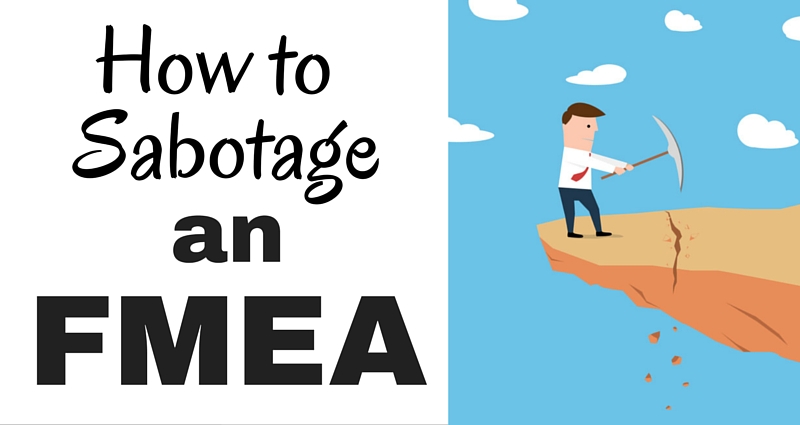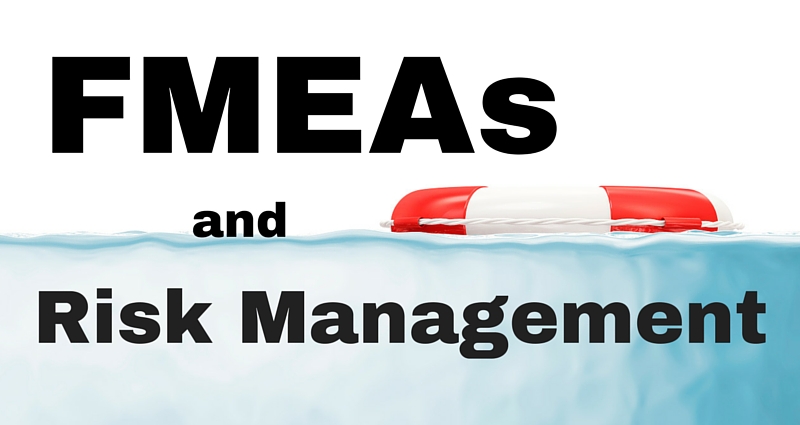If you want to make sure your Failure Mode and Effects Analysis is a bust and a waste of time, here are 10 sure-fire ways to derail an FMEA.
1: Use FMEAs to prioritize risks, but don’t do anything to reduce the risks.
- The initial output of a Failure Mode and Effects Analysis is the prioritizing of failure modes based on their risk priority numbers (RPN).
- Prioritizing does not eliminate the failure mode. Additional action (that might be outside the FMEA) is needed to mitigate risks.
2: Assign one person to conduct the FMEA on his or her own.
- Identifying failure modes is best done with team brainstorming.
- A comprehensive list of failure modes is the basis of a solid FMEA.
- One person acting alone cannot be expected to develop a rich list of potential failures.
3: Do the FMEA in an afternoon.
- It takes time to get into the details that are necessary for a strong Failure Mode and Effects Analysis.
- FMEAs conducted over several sessions allow time to gather relevant data, solicit input from others not on the team and for team members to absorb information and question findings.
4: Make the scope of the FMEA really broad.
- Taking on an entire process (or design) will be a daunting task for the FMEA team.
- Break a large process down into manageable chunks.
- If the team starts to feel that the scope is bigger than initially expected, break it into two or more smaller FMEAs.
5: Make sure that people who work in the process don’t participate in the study.
- Experienced operators should be on the team to add their perspective.
- They often have good information on failure modes and on the effectiveness of control systems.
- They might have information on occurrence as well.
6: Avoid getting into the details of the product or process.
- A superficial look at the process will miss many failure modes.
7: Focus only on external failure modes and ignore internal failures.
- Many FMEAs focus only on the customer requirements (specifications).
- Sometimes internal productivity losses, equipment damage, scrap and rework have very severe effects on the company.
8: Don’t bother customizing the Ranking Scales used to evaluate Severity, Occurrence and Detection/Prevention.
- Ranking scales should be meaningful to everyone in the organization.
- The generic rating scales might be confusing to some teams.
- Management will not be able to compare RPNs in order to prioritize activities between teams.
9: Don’t bother with mistake-proofing techniques as part of Action Plans to mitigate risk.
- FMEA is a prioritization tool. It doesn’t eliminate failure modes or effects by itself.
- Mistake-proofing is one of the most powerful ways to reduce risk.
- If the occurrence ranking can be reduced to 1 the RPN for that failure mode will be slashed.
- This is especially true with failure modes that have very severe effects.
10: Don’t tie the FMEA to a Control Plan.
- The control plan tells people how to react when a failure mode occurs.
- The FMEA will not be a living document if it is not tied to the control plan.
Helpful Resources:
 ---FMEA-Training.com Articles by Resource Engineering, Inc. are licensed under a Creative Commons Attribution-NonCommercial-NoDerivatives 4.0 International License. Permissions beyond the scope of this license may be available by contacting us.
---FMEA-Training.com Articles by Resource Engineering, Inc. are licensed under a Creative Commons Attribution-NonCommercial-NoDerivatives 4.0 International License. Permissions beyond the scope of this license may be available by contacting us.







